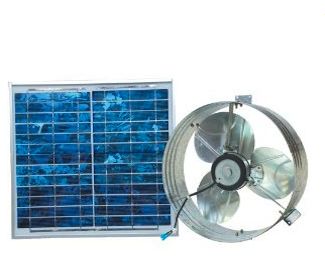Attic Ventilation
The attic space in a typical home is a kind of no-man's land. Think of attic space as the "middle man" between the outdoors and your indoor living space.
An attic in any efficient green home needs to be well-insulated to protect the indoor living spaces from the harsh outdoor temperatures, hot and cold, and to keep your heated or cooled indoor air where it belongs, indoors. A well insulated attic space will save a great deal of energy, and save you money on your heating and cooling costs.
The Importance of Attic Ventilation
While adequate attic insulation is crucial to a home's overall efficiency, there's something else an attic needs to do its job well; proper ventilation. Working together, ventilation and insulation can keep your entire house operating efficiently, as well as prevent problems that can lead to damage.
It may seem contradictory to insulate an attic only to purposely allow outside air into the space. But this ventilation is the key to the whole efficient operation.
How Attic Ventilation Works
Being the middle man between outdoors and indoors, the attic has a fine line to walk; the air in it should never be too hot, and never too cold. Whatever the season, the attic space needs to be 'just right' to facilitate maximum energy savings.
Winter: In the cold wintertime, a natural flow of cold fresh air into the attic space helps keep the space cold. This reduces the possibility of ice damming on the roof. Snow damming occurs when snow melts off a roof over an attic that is too warm and then re-freezes in the gutters, causing an ice dam that can back up and damage the roof.
Working with attic insulation and air sealing that keeps heated, moist air from the living space below the attic out, cool air ventilation in the winter helps keep the house warm without the damage associated with snow damming.
Summer: During the warmer months of the year, attic ventilation is just as important. The heat of the sun beats down on a home, which can rapidly overheat an attic space and drive up air conditioning costs. Again, proper insulation in the attic and energy efficient roofing
A well-ventilated attic again creates a natural air flow through the attic space, moving super--heated air out of the attic. This removes moisture and protects roofing materials like shingles from heat damage. Again, as in the winter months, the attic's insulation works in tandem with ventilation to keep hot air from transferring into the home's living space below.
Types of Attic Ventilation
There are a number of ways to ventilate an attic, from attic and gable vents, to ridge vents, rafter vents and soffits. All allow for the transfer of fresh air into and out of the attic space. We'll take a look at these types of attic ventilation in separate articles, as well as some high-quality, energy efficient commercial products in each category.
Proper Attic Ventilation and Insulation
One very common mistake homeowners make when insulating an attic space is thinking that if insulation is good, then more is even better. This is generally true, but attic insulation requires careful installation to make sure that soffit vents installed to provide ventilation aren't covered or plugged by the insulation.
Soffit (and rafter) vents are used to maintain proper airflow in the attic space. Attic fans are used in conjunction with them to help cool attics by drawing in cooler outside air through the attic vents (soffit, rafter, etc.) and pushing the hot attic air outside. If the attic vents are blocked by insulation, and the attic is not well-sealed from the rest of the house, the attic fans will simply suck air conditioned air right up out of the house and into the attic. This makes the air conditioning system work harder, costing you more money and unnecessarily wasting lots of energy.
By using properly-installed insulation, good air sealing, and superior attic ventilation, the home uses much less energy and totally free natural air flow to keep living spaces comfortable year-round.
comments powered by Disqus



























































































































































































